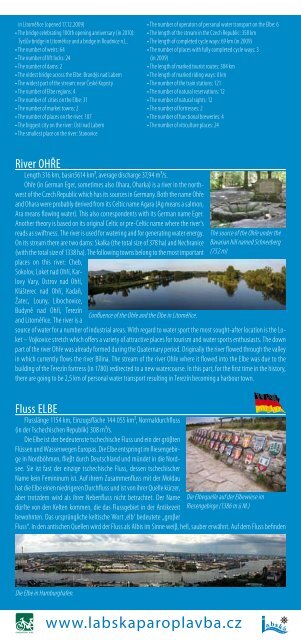brožura - Labská paroplavba
brožura - Labská paroplavba
brožura - Labská paroplavba
Erfolgreiche ePaper selbst erstellen
Machen Sie aus Ihren PDF Publikationen ein blätterbares Flipbook mit unserer einzigartigen Google optimierten e-Paper Software.
in Litoměřice (opened 17.12.2009) • The number of operators of personal water transport on the Elbe: 6<br />
• The bridge celebrating 100th opening anniversary (in 2010): • The length of the stream in the Czech Republic: 358 km<br />
Tyršův bridge in Litoměřice and a bridge in Roudnice n.L. • The length of completed cycle ways: 69 km (in 2009)<br />
• The number of weirs: 64 • The number of places with fully completed cycle ways: 3<br />
• The number of lift locks: 24 (in 2009)<br />
• The number of dams: 2<br />
• The length of marked tourist routes: 304 km<br />
• The oldest bridge across the Elbe: Brandýs nad Labem<br />
• The length of marked riding ways: 0 km<br />
• The widest part of the stream: near České Kopisty • The number of the train stations: 121<br />
• The number of Elbe regions: 4 • The number of natural reservations: 12<br />
• The number of cities on the Elbe: 31 • The number of natural sights: 12<br />
• The number of market towns: 2 • The number of fortresses: 2<br />
• The number of places on the river: 107 • The number of functional breweries: 4<br />
• The biggest city on the river: Ústí nad Labem • The number of viticulture places: 24<br />
• The smallest place on the river: Stanovice<br />
River OHŘE<br />
Length 316 km, basin5614 km², average discharge 37,94 m³/s.<br />
Ohře (in German Eger, sometimes also Ohara, Oharka) is a river in the northwest<br />
of the Czech Republic which has its sources in Germany. Both the name Ohře<br />
and Ohara were probably derived from its Celtic name Agara (Ag means a salmon,<br />
Ara means flowing water). This also correspondents with its German name Eger.<br />
Another theory is based on its original Celtic or pre-Celtic name where the river‘s<br />
reads as swiftness. The river is used for watering and for generating water energy.<br />
On its stream there are two dams: Skalka (the total size of 378 ha) and Nechranice<br />
(with the total size of 1338 ha). The following towns belong to the most important<br />
places on this river: Cheb,<br />
Sokolov, Loket nad Ohří, Karlovy<br />
Vary, Ostrov nad Ohří,<br />
Klášterec nad Ohří, Kadaň,<br />
Žatec, Louny, Libochovice,<br />
Budyně nad Ohří, Terezín<br />
and Litoměřice. The river is a<br />
Confluence of the Ohře and the Elbe in Litoměřice.<br />
source of water for a number of industrial areas. With regard to water sport the most sought-after location is the Loket<br />
– Vojkovice stretch which offers a variety of attractive places for tourism and water sports enthusiasts. The down<br />
part of the river Ohře was already formed during the Quaternary period. Originally the river flowed through the valley<br />
in which currently flows the river Bílina. The stream of the river Ohře where it flowed into the Elbe was due to the<br />
building of the Terezín fortress (in 1780) redirected to a new watercourse. In this part, for the first time in the history,<br />
there are going to be 2,5 km of personal water transport resulting in Terezín becoming a harbour town.<br />
Fluss ELBE<br />
Flusslänge 1154 km, Einzugsfläche 144 055 km², Normaldurchfluss<br />
(in der Tschechischen Republik) 308 m³/s.<br />
Die Elbe ist der bedeutenste tschechische Fluss und ein der gröβten<br />
Flüssen und Wasserwegen Europas. Die Elbe entspringt im Riesengebirge<br />
in Nordböhmen, flieβt durch Deutschland und mündet in die Nordsee.<br />
Sie ist fast der einzige tschechische Fluss, dessen tschechischer<br />
Name kein Femininum ist. Auf ihrem Zusammenfluss mit der Moldau<br />
hat die Elbe einen niedrigeren Durchfluss und ist von ihrer Quelle kürzer,<br />
aber trotzdem wird als ihrer Nebenfluss nicht betrachtet. Der Name<br />
dürfte von den Kelten kommen, die das Flussgebiet in der Antikezeit<br />
bewohnten. Das ursprüngliche keltische Wort ‚elb‘ bedeutete „groβer<br />
The source of the Ohře under the<br />
Bavarian hill named Schneeberg<br />
(752 m)<br />
Die Elbequelle auf der Elbewiese im<br />
Riesengebirge (1386 m ü M.)<br />
Fluss“. In den antischen Quellen wird der Fluss als Albis im Sinne weiβ, hell, sauber erwähnt. Auf dem Fluss befinden<br />
Die Elbe in Hamburghafen.<br />
www.labska<strong>paroplavba</strong>.cz


